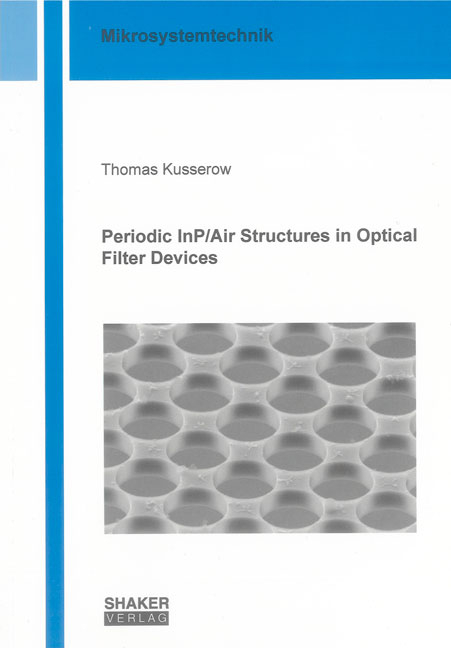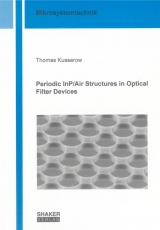Periodic InP/Air Structures in Optical Filter Devices
Seiten
2011
|
1., Aufl.
Shaker (Verlag)
978-3-8322-9900-2 (ISBN)
Shaker (Verlag)
978-3-8322-9900-2 (ISBN)
- Keine Verlagsinformationen verfügbar
- Artikel merken
Filter devices are a crucial element of analytic information systems which provide selective and evaluated signals when combined with detectors and processing units. Optical signals are advantageous due to their low susceptibility to perturbations, high potential bandwidth and fast propagation speed. Applications in the fields of data transmission or spectroscopic sensors are mainly located in the near infrared spectral range. In this thesis optical filter devices are investigated which are optimised for this spectral range and take further advantage of the properties of miniaturised structures (MEMS technology). As material system Indium Phsophide (InP) has been chosen which gives the best opportunity for integration of passive as well as active optoelectronic devices in the spectral range between 900 nm and 2400 nm.
Periodic structures are implemented as base design element since these show a strong impact on the propagation properties which cannot be achieved by absorptive or dispersive elements and are due to interference effects of the also periodic light waves. An Introduction to elements like Bragg reflectors, Fabry-Pérot filters and Photonic Crystals is given. High contrast of refractive indices in the periodic structures is desired and hence air is introduced as second material to Indium Phosphide. A process for fabrication of such air-gap Fabry-Pérot filters based on semiconductor processing technology and especially on a sacrificial layer etch process is discussed.
A scientific investigation on the residual stress in Indium Phosphide layers, caused by an arsenic carry-over effect, is presented and different methods to compensate this undesired effect are given. Studying the influence of nanooptical structures implemented in the released thin-films is part of the investigation as well. Sacrificial layer etching is one of the crucial process steps during fabrication of the filter devices and defines the quality of the resulting structures. Since this particular wet etching process has not been investigated in detail prior to this work a thorough experimental study on different parameters has been conducted in order to gain more knowledge on the specific properties. Based on the results from this research a model of selective GaInAs etching over adjacent InP layers has been established, providing better insight and leading to an improved design approach of the filter devices.
Processing technology for the monolithic integration of a photodetector element with the filter devices is discussed. Especially an opaque cover layer, reduction of the effective detector area and optimised electrical contacts are of high importance. For all these constraints different approaches are presented and researched. A detailed investigation on ohmic contacts with low resistance is conducted implementing the evaporation of Zn/Au layers. Since the condensation properties of thermally evaporated Zn are rather poor, a pre-nucleating step introducing condensation centers is studied, leading to an improved deposition rate of Zn.
High refractive indices of semiconductors in the near infrared range are rather beneficial for many optoelectronic applications, but the strong surface reflexes can also lead to severe problems. Minimising this undesired effect in multilayer Fabry-Pérot filter on InP substrates is investigated using two different methods. First a classic l/4 layer is presented then a second new method making use of a high refractive index layer is given.
A polarising element based on an InP membrane with Photonic Crystals is presented. The single layer design is optimised and considered as base for integration with a narrowband Fabry-Pérot filter. The fundamental effect used to achieve the polarising properties, are so-called Fano resonances, which describe the interference of a resonant mode inside a slab waveguide and a free space mode. By introducing a disturbance of the symmetry in a square Photonic Crystal in the form of elliptical base elements, coupling of waves to the waveguide modes becomes polarisation selective. The numerical investigation of the structures is presented as well as a fabrication process based on electron beam lithography. Improving the dry-etch durability of PMMA resist is achieved by a new method consisting of an electron beam flood exposure. In order to meet the requirements of the polarisation selective filter devices a second fabrication process based on a hard mask layer structured by FIB milling lithography and a subsequent dry-etching process is investigated. Different materials for the hard mask are considered and the resulting Photonic Crystal structures are shown. Optical characterisation of samples with elliptical base elements yields clear polarisation selective properties.
In the conclusion of this thesis the results are discussed regarding the current state of research as well as the future prospects for optical filter elements.
Periodic structures are implemented as base design element since these show a strong impact on the propagation properties which cannot be achieved by absorptive or dispersive elements and are due to interference effects of the also periodic light waves. An Introduction to elements like Bragg reflectors, Fabry-Pérot filters and Photonic Crystals is given. High contrast of refractive indices in the periodic structures is desired and hence air is introduced as second material to Indium Phosphide. A process for fabrication of such air-gap Fabry-Pérot filters based on semiconductor processing technology and especially on a sacrificial layer etch process is discussed.
A scientific investigation on the residual stress in Indium Phosphide layers, caused by an arsenic carry-over effect, is presented and different methods to compensate this undesired effect are given. Studying the influence of nanooptical structures implemented in the released thin-films is part of the investigation as well. Sacrificial layer etching is one of the crucial process steps during fabrication of the filter devices and defines the quality of the resulting structures. Since this particular wet etching process has not been investigated in detail prior to this work a thorough experimental study on different parameters has been conducted in order to gain more knowledge on the specific properties. Based on the results from this research a model of selective GaInAs etching over adjacent InP layers has been established, providing better insight and leading to an improved design approach of the filter devices.
Processing technology for the monolithic integration of a photodetector element with the filter devices is discussed. Especially an opaque cover layer, reduction of the effective detector area and optimised electrical contacts are of high importance. For all these constraints different approaches are presented and researched. A detailed investigation on ohmic contacts with low resistance is conducted implementing the evaporation of Zn/Au layers. Since the condensation properties of thermally evaporated Zn are rather poor, a pre-nucleating step introducing condensation centers is studied, leading to an improved deposition rate of Zn.
High refractive indices of semiconductors in the near infrared range are rather beneficial for many optoelectronic applications, but the strong surface reflexes can also lead to severe problems. Minimising this undesired effect in multilayer Fabry-Pérot filter on InP substrates is investigated using two different methods. First a classic l/4 layer is presented then a second new method making use of a high refractive index layer is given.
A polarising element based on an InP membrane with Photonic Crystals is presented. The single layer design is optimised and considered as base for integration with a narrowband Fabry-Pérot filter. The fundamental effect used to achieve the polarising properties, are so-called Fano resonances, which describe the interference of a resonant mode inside a slab waveguide and a free space mode. By introducing a disturbance of the symmetry in a square Photonic Crystal in the form of elliptical base elements, coupling of waves to the waveguide modes becomes polarisation selective. The numerical investigation of the structures is presented as well as a fabrication process based on electron beam lithography. Improving the dry-etch durability of PMMA resist is achieved by a new method consisting of an electron beam flood exposure. In order to meet the requirements of the polarisation selective filter devices a second fabrication process based on a hard mask layer structured by FIB milling lithography and a subsequent dry-etching process is investigated. Different materials for the hard mask are considered and the resulting Photonic Crystal structures are shown. Optical characterisation of samples with elliptical base elements yields clear polarisation selective properties.
In the conclusion of this thesis the results are discussed regarding the current state of research as well as the future prospects for optical filter elements.
| Reihe/Serie | Berichte aus der Mikromechanik |
|---|---|
| Sprache | englisch |
| Maße | 148 x 210 mm |
| Gewicht | 303 g |
| Einbandart | Paperback |
| Themenwelt | Technik ► Elektrotechnik / Energietechnik |
| Schlagworte | InP • MEMS • Optics • periodic structures • Photonic Crystals |
| ISBN-10 | 3-8322-9900-9 / 3832299009 |
| ISBN-13 | 978-3-8322-9900-2 / 9783832299002 |
| Zustand | Neuware |
| Haben Sie eine Frage zum Produkt? |
Mehr entdecken
aus dem Bereich
aus dem Bereich
Kolbenmaschinen - Strömungsmaschinen - Kraftwerke
Buch | Hardcover (2023)
Hanser (Verlag)
49,99 €




